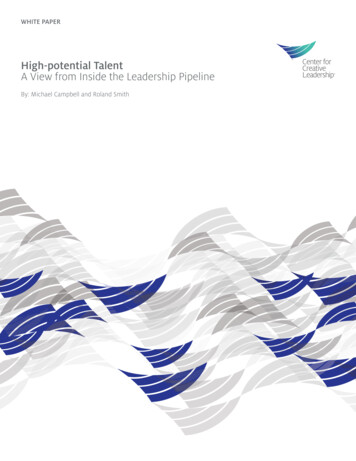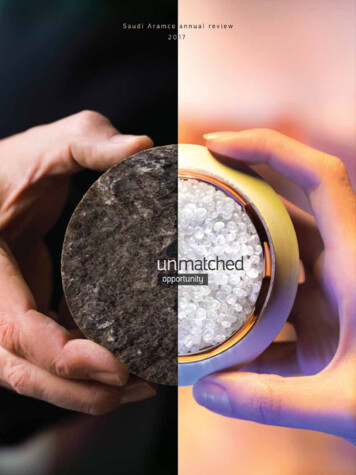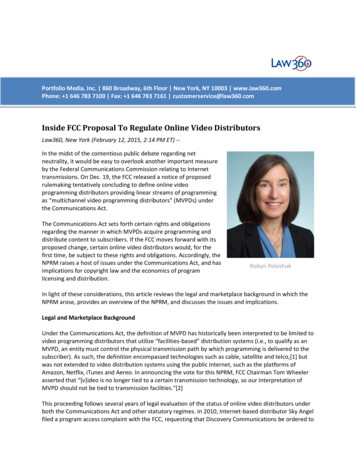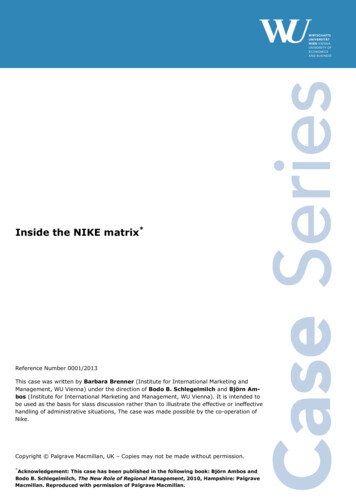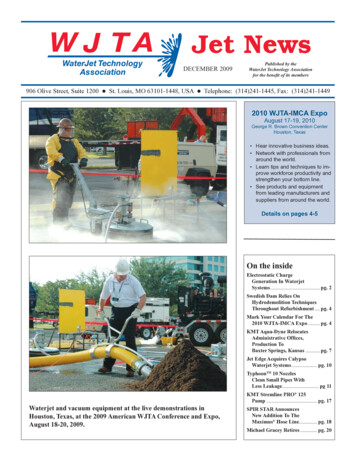
Transcription
DECEMBER 2009Published by theWaterJet Technology Associationfor the benefit of its members906 Olive Street, Suite 1200 l St. Louis, MO 63101-1448, USA l Telephone: (314)241-1445, Fax: (314)241-14492010 WJTA-IMCA ExpoAugust 17-19, 2010George R. Brown Convention CenterHouston, Texas Hear innovative business ideas. Network with professionals fromaround the world. Learn tips and techniques to improve workforce productivity andstrengthen your bottom line. See products and equipmentfrom leading manufacturers andsuppliers from around the world.Details on pages 4-5On the insideElectrostatic ChargeGeneration In WaterjetSystems. pg. 2Swedish Dam Relies OnHydrodemolition TechniquesThroughout Refurbishment. pg. 4Mark Your Calendar For The2010 WJTA-IMCA Expo. pg. 4KMT Aqua-Dyne RelocatesAdministrative Offices,Production ToBaxter Springs, Kansas. pg. 7Jet Edge Acquires CalypsoWaterjet Systems. pg. 10TyphoonTM 10 NozzlesClean Small Pipes WithLess Leakage. pg 11Waterjet and vacuum equipment at the live demonstrations inHouston, Texas, at the 2009 American WJTA Conference and Expo,August 18-20, 2009.KMT Stremline PRO 125Pump. pg. 17SPIR STAR AnnouncesNew Addition To TheMaximus Hose Line. pg. 18Michael Gracey Retires. pg. 20
Electrostatic Charge Generation In Waterjet SystemsBy: Paul L. Miller, Gradient Technology, Elk River, MinnesotaABSTRACT1.1 Static Electricity FundamentalsThe use of waterjets can generateelectrostatic charges that arepotentially hazardous to personnel andharmful to equipment and product.Several serious fires have beenattributed to static discharge duringwaterjet cleaning operations, andstatic electric arc discharge has beenknown to damage composite materials.The waterjet industry’s trend towardusing higher velocity liquid jets andhigher purity water increases the riskof electric spark generation as shownby theoretical analysis and empiricaltesting. This paper identifies themechanisms related to static electriccharge generation during waterjetoperations and the corrective measuresnecessary to control potentiallyhazardous electrostatic discharge.Static electricity is caused by thebuildup of an electrical chargeimbalance, with one item’s having anexcess of electrons and another item’shaving a deficiency of electrons. Thetransfer of electrons to balance outthe systems is called an electrostaticdischarge. Since the speed ofelectricity is functionally the sameas the speed of light, or about 3.0 x108m s-1, when using a good conductorthe transfer rate can be extremelyfast. Nonconductive materials cansubstantially slow down the rate ofelectron transfer and can effectivelyprevent electrons from flowing.1.0 IntroductionThe presence of static electricity hasbeen known since early Greece, andmost likely long before. The modernword “electron” is derived from theGreek word for the material known tous as amber, as it was commonly usedfor developing a static electric charge.For most technologies throughouttime the build-up of static electricitywas little more than a nuisance. Acentury ago the worst effects a personcould expect from static electricitywas a jolt when touching a doorknobon a winter’s day. It was not untilcombustible dusts and flammableliquids became more prevalent that themore serious hazards of electrostaticdischarge (ESD) became well known.Modern fluid jet equipment has thepotential of generating thousands ofvolts of electricity and has causedseveral spectacular fires fromundesired ESD generation aroundflammable materials.Page 2These items can include computercomponents, photographic film,electrical equipment, and compositelaminates. In some extreme cases,workers can be injured or evenmetallic structures damaged fromESD.In most of the cases the ESD damageis from a localized melting of anitem due to the extreme levels of heatgenerated by a miniscule electricarc. Integrated circuit componentsare especially vulnerable to suchdischarge and can even be damaged bythe amount of electricity accumulatedwhen people walk across a floor. TheESD sensitivity standards for electricalcomponents is shown in Table 2When two different unchargedEven more important is the potentialmaterials are in contact, an “electricalfor ESD to ignite flammable liquidsdouble layer” forms where electronstransfer back and forth with a “contact and combustible dusts. As shown inTable 3, the amount of energy requiredpotential” of between 1.0 x 10-3 to 1.0-1to ignite common flammable materialsx 10 volts. When two conductiveis rather low. A more unusual concernmaterials are used, the electrons canis in locations where ESD can ignitequickly transfer back and correctexplosive materials at very lowany differences in electron balance.electrical energy levels as shown inHowever, when a nonconductive (orTable 4. Explosive materials usuallyinsulating) material is used, some ofreceive extreme attention in suchthe electrons can be “trapped” on itssituations, but flammable liquids andsurface and the imbalance in electrongases actually require substantiallyquantities can create an electricalpotential. The length of time required(continued on page 12)for the electrical charges to dissipatefrom a given material isTable 1. Relaxation Time for Hydrocarbons ofknown as the “relaxationDiffering Conductivities (Eichel, 1967)time.” The relaxationtime for hydrocarbons ofConductivityRelaxation Timedifferent conductivities isMaterial-1(mho m)secondsshown in Table1.1.2 ElectrostaticDischarge DamageMany common modernmaterials and equipmentcan be damaged byelectrostatic discharge.10-202.196 x 105hexane102.196 x 10benzene-19410-182.196 x 10310-172.196 x 102xylene10-162.196 x 101toluene102.196 x 10-15WJTA on the web: www.wjta.org0December 2009
Swedish Dam Relies On Hydrodemolition TechniquesThroughout RefurbishmentHydrodemolition techniquesare being used for therefurbishment contract on Sweden’sJäpströmmen hydropower stationdam wall and three spillway gatesusing Aquajet’s Aqua Cutter robotichydrodemolition equipment.Working conditions includedunderwater operations and night-timetemperatures of -25ºC.Swedish hydrodemolition specialistE-Schakt has started work on themajor refurbishment contract for theconcrete dam and three spillways,some 80 km west of Ostersund, midSweden, to meet increased watervolumes.Built in 1944 and located on LakeKallsjön, the dam walls and concretestructures of the three spillway gateshave badly deteriorated as a result ofpoor initial construction methods andmaterials and subsequent maintenance.The region experiences severe subzero temperatures throughout thewinter creating considerable frost andice damage across the concrete faceswith extensive cracking. Major mossgrowth on the concrete walls in thesummer months has further aggravatedthe situation resulting in water seepageinto the concrete fissures.A two-year contract has beenawarded to Skanska for the completerefurbishment of the dam walls, gatestructures and three spillway gates, byFortum, the private company operatorof the power station supplying powerinto the country’s national grid.Phases 1-3E-Schakt was awarded a threephase sub-contract with work onPhase 1 starting in September 2009for the concrete removal on the topslab and down-side wall of the dam,Page 4plus the gate 3 structure, alldemanding hydrodemolitiontechniques. Skanska willthen replace the treatedareas with new concrete andwhere necessary, new rebar.Phase 2 is scheduled tostart in May 2010, againusing hydrodemolition onthe lake-side dam wall,including underwateroperations and gateway 2.Vertical operation on the dam wall.The third 12-week contractis planned for November 2010and will include gate 1 plus theremoval of a small fourth gateand replaced by a new dam wallstructure.Use of hydrodemolitiontechniques ensures no rebardamage, minimized risk of goodconcrete removal, eliminates(continued on page 6)The Aqua Frame on the inclined damabutment.Mark Your Calendar For The 2010WJTA-IMCA ExpoWJTA and IMCA will host theinaugural WJTA – IMCAExpo, August 17-19, 2010, atthe George R. Brown (GRB)Convention Center in Houston,Texas.The WJTA – IMCA Expo willfeature an expanded exhibit hall andboot camp sessions for individualsand companies in the waterjet andindustrial vacuuming industries,including applications in precisionwaterjet cutting, industrial cleaning,and other applications in themanufacturing, mining, construction,and process industries.WJTA on the web: www.wjta.orgExhibit displays will includeequipment, products and servicesrelating to precision waterjet cutting,industrial cleaning, waterblasting,hydrodemolition, surfacepreparation, and industrial vacuumequipment/trucks. There will be livetable top precision waterjet cuttingin the exhibit hall.To reserve exhibit space, contactKen Carroll by phone: 314-2411445, fax: 314-241-1449, or email:wjta-imca@wjta.org. The exhibithall floor plan and an application forexhibit space are available online atwww.wjta.org.December 2009
2010 WJTA-IMCA ExpoAugust 17-19, 2010George R. Brown Convention CenterHouston, TexasPreliminary Schedule of EventsTuesday, August 176:30-8:30 P.M.Welcoming ReceptionWednesday, August 189:00 A.M.-5:00 P.M.Exhibit Hall Open9:30 A.M.-5:00 P.M.Boot Camp SessionsThursday, August 199:00 A.M.-3:00 P.M.Exhibit Hall Open9:30 A.M.-3:00 P.M.Boot Camp SessionsReserve Your Exhibit SpaceMake plans now to exhibit at the 2010 WJTAIMCA Expo. To reserve exhibit space, contact KenCarroll by phone: 314-241-1445, fax: 314-2411449, or email: wjta-imca@wjta.org. The exhibithall floor plan and an application for exhibit spaceare available online at www.wjta.org.Opportunities To Win Attendance Prizes - Expo registrantsare eligible to win one of eight 250 cashprizes. Attendance prizes sponsored byHigh Pressure Equipment Company. Exhibit Passport - Complete your ExhibitPassport for a chance to win one of four 50 cash prizes. Expo Survey - Complete your Exposurvey and enter to win one of two 50cash prizes.Page 5
Swedish Dam Relies On Hydrodemolition Techniques Throughout Refurbishment, from page 4dust and crystalline silica pollutionand leaves a superior bonding surface.It is also substantially faster thanmechanical removal methods and isalso considerably less labor intensive.HydrodemolitionE-Schakt is using hydrodemolitionequipment from Sweden’s AquajetSystems and includes an HVDEvolution Aqua Cutter robot, an AquaFrame for underwater operations and aPP-700 Ecosilence power pack.Dam WallFeaturing a total length of 41.8 m,the all-concrete dam structure has amaximum height of 14 m, a 2.5 mwide top slab and 6 m wide base.In Phase 1, E-Schakt has removed500 mm depth of concrete fromthe top slab and within a five-weekperiod virtually completed thehydrodemolition of the dam’s damside wall to a depth of 200 mm usingboth the Aqua Cutter robot and AquaFrame for the angled face.A key feature of the Aquajetrobot has been the ability toundertake geometric triangularcuts, according to E-Schakt’s siteforeman, Andreas Nordström. Withthree triangular sections of the wallface each measuring 4 m x 2 m, thesystem eliminated the need for timeconsuming alternative methods.“Another advantage has been the 12m high mast, which has allowed us towork at the maximum height,” saysNordström.A 1 m deep channel excavated alongthe dam face will provide access forthe Aqua Cutter robot to continueremoving deteriorated concrete belowPage 6the ground level.During the second phasecontract, E-Schakt willremove 5.5 m of concreteon the vertical elementof the upstream side ofthe dam to a depth of 200mm, including at least 1 munderwater.For this operation, theAqua Frame robot willbe positioned on thevertical upstream damwall and be secured to thewall by divers. Then, inclose collaboration withthe Skanska divers, theE-Schakt operator cancontinue the underwaterhydrodemolition operationremotely from above thesurface.Vertical removal.The Aqua Frame includes8 meter side rails with aEvolution robot removing a triangle part of the4 meter traverse rail tosupport the oscillating lance cracked concrete.in the traversing power headwith its nozzle to continue operating at1000 bar at a rate of 260 l/min – 330 l/min depending on the removal depth.Spillway GatesThe Järpströmmen installationfeatures three steel spillway gates, onewith a gate well and two without awell, featuring concrete slab spillways.The three gates provide a total lengthof almost 60 m and a maximum heightof 16 m.Throughout each of the threephases of refurbishment, a single gatewill be removed in turn for blastingand retreatment. Hydrodemolitiontechniques on all concrete structuresto the gates will follow removal of thegate.WJTA on the web: www.wjta.org10 meter high vertical removal fromthe dam.(continued on page 9)December 2009
KMT Aqua-DyneRelocates Administrative Offices,Production To BaxterSprings, KansasKMT Aqua-Dyne, a leadingglobal manufacturer of waterblasting pumps, custom equipment,and high pressure componentsmoved its administrative officesand production facilities fromHouston, TX to Baxter Springs, KSon November 10, 2009. Service andsales staff will remain in Houston,TexasThis move will allow KMT AquaDyne to take advantage of a state-ofthe-art production facility along withimproving customer service not onlyto its North America customers, butalso customers around the world. Theproximity to KMT Waterjet will allowKMT Aqua-Dyne to incorporateadvanced technology into its currentand future products. KMT Waterjet isa world leader in waterjet technologyfor quality, reliability, and service.KMT Waterjet has over 40 years ofexperience in the ultra high pressurewaterjet industry.For more information, visit www.aqua-dyne.com or contact ClaytonBurleson by telephone: (620)8566274, email: clayton.burleson@aquadyne.com, or mail: KMT Aqua-Dyne,635 West 12th St. Baxter Springs, KS66713.Comments Solici
KMT Aqua-Dyne Relocates Administrative Offices, Production To Baxter Springs, Kansas.pg. 7 Jet Edge Acquires Calypso Waterjet . Aqua Frame robot will be positioned on the vertical upstream dam wall and be secured to the wall by divers. Then, in close collaboration with the Skanska divers, the E-Schakt operator can . KMT Aqua-Dyne and . The . of ) .* .* / -" " /-# % % % % % .



